Mars Express helps uncover the secrets of Perseverance landing site
1 July 2020
Mapping the ancient lakeshores, diverse minerals and violent volcanism of Jezero craterTwo studies based on ESA's Mars Express observations of Jezero crater, the future landing site for NASA's 2020 Mars Perseverance rover, have shed light on how and when this intriguing area formed – and identified the regions most likely to reveal signs of ancient life.
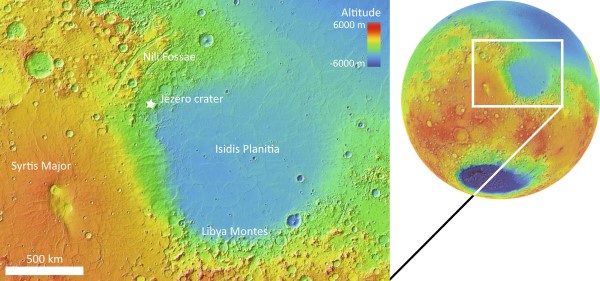 |
| The topography of Nili Fossae on Mars. Credit: Courtesy of L. Mandon et al. (2020) |
NASA's Mars 2020 Perseverance rover will search for signs of past life on Mars and collect samples for a future flight to Earth. NASA and ESA are currently working together on mission concepts to bring these samples to Earth by 2031.
Two studies based on data from another space mission – ESA's Mars Express, orbiting the Red Planet since 2003 – now identify which parts of the rover's landing site are most likely to have preserved ancient signs of life, climate, water, and volcanism. Both studied a part of Mars' surface known as Nili Fossae and, more specifically, a crater within this area named Jezero crater.
Jezero crater contains a delta, clear evidence that water once flowed there in the form of an ancient lake, and holds large quantities of both olivine and carbonate minerals. Carbonates form in the presence of water and are known to trap biosignatures, the signatures of life, whereas olivine is present in magmatic rocks and can be used to explore and precisely date Mars' volcanic past.
"We've known for decades now that Nili Fossae is quite a unique part of Mars, and Jezero crater was chosen as a landing site for the Perseverance rover given this uniqueness," says Lucia Mandon of the Laboratoire de Géologie de Lyon (Terre, Planètes, Environnement), France, and lead author of a study into the mineralogy, age, and evolution of the Nili Fossae region.
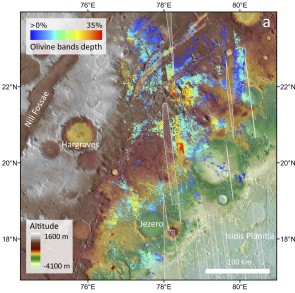 |
| Mapping the olivine layers around Perseverance's landing site. Credit: Courtesy of L. Mandon et al. (2020) |
"However, while this part of Mars has been well-studied, scientists were still unsure about how and when it formed, or how it came to contain all of this olivine- and carbonate-rich material. In fact, at least six different formation scenarios have been proposed in the last couple of decades."
To resolve this uncertainty, Lucia and colleagues analysed observations of the Nili Fossae region gathered by ESA's Mars Express and NASA's Mars Reconnaissance Orbiter (MRO): a mix of high-resolution images, topographic data, mineralogical data, and thermal data. They found that the olivine-rich bedrock in the region around Jezero crater extends for at least 18 000 square kilometres, and formed around 3.8 billion years ago.
"One of the most popular formation theories suggests that the olivine-bearing material formed as a sheet of melted rock, created by the giant impact that produced the huge nearby Isidis basin," adds Lucia, "but our timeline reveals that the olivine-rich bedrock formed tens of millions of years or more after this impact."
"However, we think that this impact made the crust fragile and more prone to volcanism. After reviewing all plausible scenarios, we found that the Nili Fossae region was most likely sculpted by massive eruptions of ash and other material thrown out from giant volcanoes. The erupted volume is colossal: more than 1000 times larger than that of the Vesuvian event that destroyed Pompeii in 79 AD."
This suggests that the common view of Martian volcanism, in which volcanic activity broadly occurs via lava flows with only a few instances of explosive activity, may not be wholly accurate.
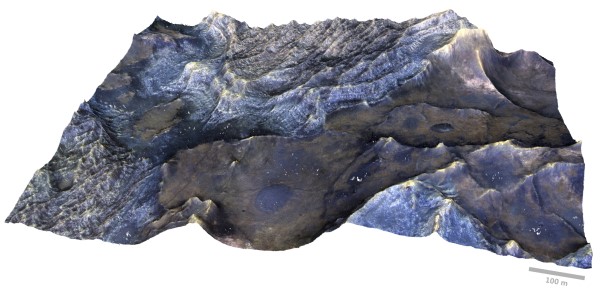 |
| The olivine-rich terrain in the vicinity of Jezero crater. Credit: NASA/JPL/University of Arizona; image processing: L. Mandon |
Lucia and colleagues also mapped the carbonates present across Nili Fossae, with some of the strongest detections occurring close to the Perseverance rover's landing site. These minerals are known to form in fairly neutral waters – environments that are friendly to most of the forms of life we know on Earth.
"Carbonates that form along lakeshores on Earth are fantastic for preserving biosignatures," says Briony Horgan of Purdue University, USA, lead author on a complementary paper on the distribution and origin of carbonate-bearing rocks in Jezero crater.
"Alkaline lakes that produce carbonates on Earth are almost always inhabited by stromatolites – large mineralised domes created by layers of microbial mats that have been known to preserve some of the clearest biosignatures from billions of years ago on our planet. While we don't know if we might find stromatolites on Mars, this lakeshore environment would be a great place to hunt for biosignatures and organic molecules from Mars' earlier days."
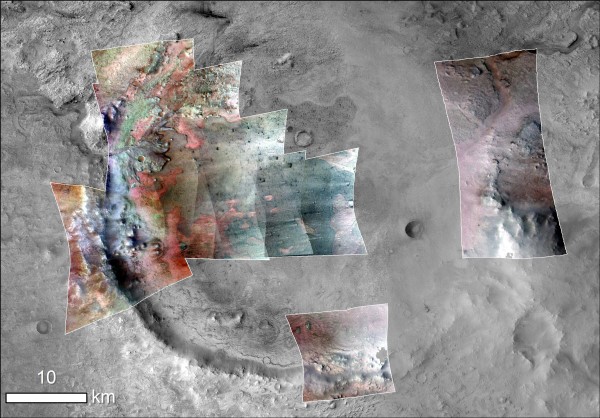 |
| Jezero crater minerals. Credit: NASA/JPL-Caltech/MSSS/JHU-APL/Purdue/USGS |
Jezero crater is the only known location on Mars where carbonates have clearly been detected in close proximity to features indicating the presence of an ancient lake. Briony and colleagues investigated the crater using data from Mars Express and MRO, exploring whether the carbonates formed within this lake or as a result of other processes, such as alteration by rain.
They found that, while carbonates are present throughout the crater, there is a ring of strong carbonate signatures at elevations where the ancient lake's shoreline would have been. This suggests that those particular carbonates likely precipitated on the shore of the lake, making them especially exciting for studies of both water and potential past life on Mars.
"These carbonates will be key targets for the Mars 2020 and Mars Sample Return missions because of their high potential to preserve biosignatures," adds Briony. "We're hoping that we'll be able to get to the shoreline area during the primary mission for Mars 2020. This ring of carbonates at the old water level along Jezero's western rim will be a particularly exciting part of the crater to explore."
One of the key lines of evidence for the possible lakeshore carbonates came as a result of topography derived by Mars Express' High Resolution Stereo Camera (HRSC). Briony and colleagues used the topographic data gathered by Mars Express from orbit to determine the elevation of these minerals within the crater: essential to determine how they formed.
Together, this research elucidates the history and nature of a crucial part of the martian surface. When Perseverance lands in Jezero crater, it will investigate both the olivine-rich bedrock and the carbonate ring studied by Lucia, Briony, and colleagues; the rover team is also planning to gather samples of the bedrock for future return to Earth.
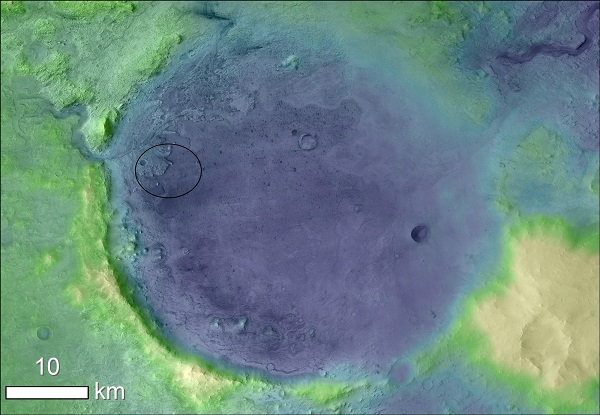 |
| Jezero crater's ancient lakeshore. The oval indicates the Mars 2020 landing ellipse. Credit: NASA/JPL-Caltech/MSSS/JHU-APL/ESA |
"With a sample return mission, we'd then be able to precisely date these samples in a laboratory, and compare this age to the one we've inferred from orbit," adds Lucia. "This would allow us to calibrate the whole martian chronology system, and is a key example of why Mars Sample Return is so exciting and valuable."
Launched 17 years ago, Mars Express has been in orbit around Mars since December 2003, and carries a suite of advanced instruments on board. These studies used data from the spacecraft's HRSC camera and OMEGA (Observatoire pour la Minéralogie, l'Eau, les Glaces et l'Activité) imaging spectrometer.
"While HRSC maps the topography of Mars' surface down to a few tens of metres per pixel, OMEGA produces detailed visible and near-infrared images that researchers can use to identify surface minerals," adds Dmitri Titov, ESA Project Scientist for Mars Express.
"These instruments, together with those on MRO, were key to accurately map the extent of olivine-carbonate material within Jezero crater, as they're able to cover large areas of the surface and provide detailed information on its topography and mineralogy.
"It's hugely exciting to consider how the numerous missions currently at Mars will support and build upon the findings of the Perseverance rover when it reaches this scientifically exciting area of the martian surface. Mars Express has 16 years of experience at the planet, which will prove invaluable to future exploration and sample return efforts."
Notes to editors
"The mineral diversity of Jezero crater: Evidence for possible lacustrine carbonates on Mars" by B. H. N. Horgan et al. (2020) and "Refining the age, emplacement and alteration scenarios of the olivine-rich unit in Nili Fossae region, Mars" by L. Mandon et al. (2020) are published in the journal Icarus.
For further information please contact:
Lucia Mandon
Laboratoire de Géologie de Lyon – Terre, Planètes, Environnement
Université de Lyon, France
Email: lucia.mandon![]() univ-lyon1.fr
univ-lyon1.fr
Briony Horgan
Purdue University, Indiana, USA
Email: briony![]() purdue.edu
purdue.edu
Dmitri Titov
ESA Mars Express project scientist
Email: dmitri.titov![]() esa.int
esa.int





